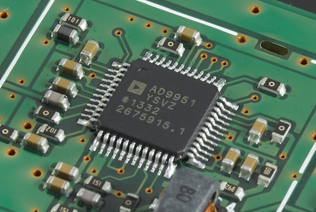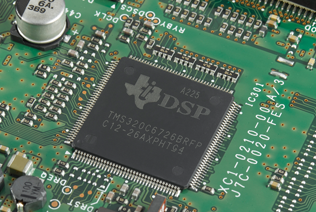

1st IF frequency (11.374 MHz) down conversion* is employed when receiving on 15, 20, 40, 80 or 160 meter bands. Included as standard directly after the 1st Mixer and Post Amp that compensates for conversion loss is a BW 500 Hz and 2.7 kHz 6-pole MCF, which determines adjacent receptivity, realizing superb dynamic range performance that was not possible using up conversion. Even when an interfering signal approaches the reception frequency, a virtually flat dynamic range is maintained. You can capture a clear signal even in reception conditions where strong adjacent interfering signals become problematic.
*Down conversion is selected automatically when receiving in CW/FSK/SSB modes if the final passband is 2.7 kHz or less.


This is a method in which, for the 1st local oscillator, instead of employing conventional PLL/VCO, the output of a DDS (Direct Digital Synthesizer) is supplied directly to the Mixer.During down conversion, the oscillation frequency is lower than it is in up conversion, so even better C/N (Carrier to Noise ratio) characteristics can be achieved. As a result, the characteristics for reciprocal mixing due to the large input signal approaching the reception signal are improved.


It would be no exaggeration to say that KENWOOD's reception audio, which enjoys a reputation for being non-tiring even in long contests, is determined by IF AGC control based on unique DSP algorithms. This series features all of the IF DSP AGC technology developed with the TS-990S. A remodeling of the AGC circuitry has realized superb AGC performance covering from small to large inputs. Even if interference signals slip between the Roofing Filter and the IF DSP filter that determines the final selection, leveloptimized AGC control enables operation without the need for awareness of Roofing Filter bandwidth.


This operates as the passband HI CUT/LO CUT function in SSB/AM/FM modes, and as the WIDTH/SHIFT control function in CW/FSK/SSB-DATA modes. Operation can be switched using the menu in SSB and SSB-DATA modes.

Remove a powerful interfering signal with a notch filter to capture a weak target signal. Choose from automatically variable notch frequency in IF Auto-Notch*1 and manually adjustable notch frequency in Manual Notch*2 depending on your interference situation.
*1:Available only in SSB mode
*2:Available in SSB/CW/FSK modes

One-touch A/B switching
FIL A/B can be set independently with VFO A/B. This convenient function enables swift operation during contests or split operation.
In addition to the analog noise blanker (NB1), which has a proven track record for eliminating weak noise, this transceiver is equipped with a digital noise blanker (NB2). The optimum blanker for the type of noise and reception conditions can be selected. NB1 enables stable noise suppression independent of reception bandwidth, while NB2 is effective against noise that defies tracking by an analog noise blanker.
This series features 2 kinds of noise reduction methods: NR1 and NR2. NR1 applies the most optimum kind of noise reduction for each reception mode, while NR2 employs the SPAC method, which is more effective for CW operation.
Spectral-subtraction noise reduction has been developed with a focus on improving reception clarity for weak SSB signals. It enables the bringing to the surface of a target signal that is swamped by noise, without any loss in sound quality. For non-speech modes (CW/FSK), a line enhancer offers tried and true noise reduction.

NR2 is SPAC-based noise reduction that is effective for CW operation as i t can suppress noise at the same frequency as the target signal (not available for FM mode).

Whereas IF auto notch is effective against a single, powerful beat, the beat cancel feature works well when there are multiple, weak beats. BC1 is effective to remove weak and/or continuous beat interference, while BC2 is effective for intermittent beats like CW signals.